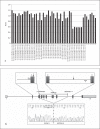Hereditary Hemorrhagic Telangiectasia: Breakpoint Characterization of a Novel Large Deletion in ACVRL1 Suggests the Causing Mechanism
- PMID: 23653583
- PMCID: PMC3638981
- DOI: 10.1159/000347029
Hereditary Hemorrhagic Telangiectasia: Breakpoint Characterization of a Novel Large Deletion in ACVRL1 Suggests the Causing Mechanism
Abstract
Hereditary hemorrhagic telangiectasia (HHT) is an autosomal dominant vascular dysplasia. Mutations in either ENG or ACVRL1 account for around 85% of cases, and 10% are large deletions and duplications. Here we present a large novel deletion in ACVRL1 gene and its molecular characterization in a 3 generation Italian family. We employed short tandem repeats (STRs) analysis, direct sequencing, multiplex ligation-dependant probe amplification (MLPA) analysis, and 'deletion-specific' PCR methods. STRs Analysis at ENG and ACVRL1 loci suggested a positive linkage for ACVRL1. Direct sequencing of this gene did not identify any mutations, while MLPA identified a large deletion. These results were confirmed and exactly characterized with a 'deletion-specific' PCR: the deletion size is 4,594 bp and breakpoints in exon 3 and intron 8 show the presence of short direct repeats of 7 bp [GCCCCAC]. We hypothesize, as causative molecular mechanism, the replication slippage model. Understanding the fine mechanisms associated with genomic rearrangements may indicate the nonrandomness of these events, highlighting hot spots regions. The complete concordance among MLPA, STRs analysis and 'deletion-specific PCR' supports the usefulness of MLPA in HHT molecular analysis.
Keywords: ACVRL1; Large deletion; MLPA; Short direct repeats; Slippage.
Figures


Similar articles
-
Hereditary hemorrhagic telangiectasia: two distinct ENG deletions in one family.Clin Genet. 2010 Nov;78(5):484-9. doi: 10.1111/j.1399-0004.2010.01418.x. Clin Genet. 2010. PMID: 20412114
-
National mutation study among Danish patients with hereditary haemorrhagic telangiectasia.Clin Genet. 2014 Aug;86(2):123-33. doi: 10.1111/cge.12269. Epub 2013 Oct 3. Clin Genet. 2014. PMID: 24001356
-
Characterization of five novel large deletions causing hereditary haemorrhagic telangiectasia.Clin Genet. 2008 Apr;73(4):320-30. doi: 10.1111/j.1399-0004.2008.00968.x. Epub 2008 Feb 26. Clin Genet. 2008. PMID: 18312453
-
Hereditary hemorrhagic telangiectasia. Genetics, pathogenesis, clinical manifestation and management.Saudi Med J. 2007 Jan;28(1):11-21. Saudi Med J. 2007. PMID: 17206283 Review.
-
Hereditary hemorrhagic telangiectasia: genetics and molecular diagnostics in a new era.Front Genet. 2015 Jan 26;6:1. doi: 10.3389/fgene.2015.00001. eCollection 2015. Front Genet. 2015. PMID: 25674101 Free PMC article. Review.
References
-
- Abeysinghe SS, Chuzhanova N, Krawczak M, Ball EV, Cooper DN. Translocation and gross deletion breakpoints in human inherited disease and cancer I: nucleotide composition and recombination-associated motifs. Hum Mutat. 2003;22:229–244. - PubMed
-
- Bacolla A, Wojciechowska M, Kosmider B, Larson JE, Wells RD. The involvement of non-B DNA structures in gross chromosomal rearrangements. DNA Repair (Amst) 2006;5:1161–1170. - PubMed
-
- Bayrak-Toydemir P, McDonald J, Akarsu N, Toydemir RM, Calderon F, et al. A fourth locus for hereditary hemorrhagic telangiectasia maps to chromosome 7. Am J Med Genet A. 2006;140:2155–2162. - PubMed
-
- Chen JM, Chuzhanova N, Stenson PD, Ferec C, Cooper DN. Complex gene rearrangements caused by serial replication slippage. Hum Mutat. 2005a;26:125–134. - PubMed
-
- Chen JM, Chuzhanova N, Stenson PD, Ferec C, Cooper DN. Meta-analysis of gross insertions causing human genetic disease: novel mutational mechanisms and the role of replication slippage. Hum Mutat. 2005b;25:207–221. - PubMed
LinkOut - more resources
Full Text Sources
Other Literature Sources

